#gundam reference
Explore tagged Tumblr posts
Text
Not to mention - it's no wonder Witch From Mercury was inspired by Heaven Will Be Mine. Heaven Will Be Mine had lesbian gundam, hell, trans lesbian gundam, and the most R18 thing on steam without explicitly showing genitals in a visual novel. Damn.
It's ouroboros: the snake eats its own tail. Snake eater eats gundam gets eaten by heaven will be mine, gets eaten back by a bigger gundam.
7 notes
·
View notes
Text
instead of referencing the akira bike slide we should reference the Last Shooting from gundam

( i dont know what else to tag as a cw so please let me know !! )
#gundam reference#oc#art#vcr aesthetic#vhs aesthetic#robot gore#missing head#i lost SO much detail when i put this through the vcr i'm so sad#fixed up the fucked up rocks in the bg though lmaooooo
3 notes
·
View notes
Text
I mostly think this poll is hilarious (and some people are taking it way, way too seriously) but it’s starting to get really weird how often people on the opposite side are dismissing Gundam — a giant of science fiction that remade a genre in its image — and quite literally lying about Suletta and Miorine. I’ve seen people claim they were canonically married to men, people claim the show’s ending was rewritten by interns, claim they never hugged, and other claims regarding them not being canon.
While Bandai and Kadokawa did censor one interview, and Bandai released an “open to interpretation” statement, these no longer hold true. Official material has henceforth referred to them as married. One instance of censorship and a statement they’ve clearly walked back on does not erase the fact that the show itself heavily emphasizes their wedding rings, refers to Miorine as Eri’s sister-in-law, and makes it abundantly clear that they are married.
“I knew I was going to make an epilogue, but it was a while before I decided upon the exact number of years that should pass in-between. The ending itself follows “The Tempest,��� and depicts Suletta and Miorine getting married and becoming partners.”
- Hiroshi Kobayashi
They are completely and unambiguously canon, and arguably were never decanonized to begin with given the literal text of the show.
An addendum to this: I’ve also seen a strange dismissal of the history that G-Witch pulls from.
The original Gundam inspired Revolutionary Girl Utena, with Lalah Sune in particular (the creator of an iconic Gundam archetype) serving as the inspiration for Anthy Himemiya. Gundam has had a queer fanbase for decades, and has had gay characters (with Yoshiyuki Tomino himself confirming this) since the 1990s.
G-Witch draws from Gundam’s extensive, genre-shaking history, classics like Utena and Rose of Versailles, and Shakespeare’s The Tempest. It brings Gundam and Utena’s connection full circle, and is in conversation with every Gundam series that came before it.
It’s unfair to dismiss it as just some random show, or — as I’ve seen some do — credit its open queerness to the influence of completely unrelated American media, as if Japan is utterly devoid of gay people.
#alex.txt#they refer to each other as bride and groom from episode one onwards.#gundam the witch from mercury#g witch#suletta mercury#sulemio#miorine rembran#racism and misogyny absolutely factor into this#as well as a disturbing trend of western centrism#are most of the people opposing sulemio like this?#of course not. most are just voting for the pairing they enjoy.#but for the minority i’ve seen being truly vile?#and being hideously dismissive?#please examine why it’s the interracial lesbian couple#from a japanese production#that you’re treating as lesser#compared to two white american men
2K notes
·
View notes
Text
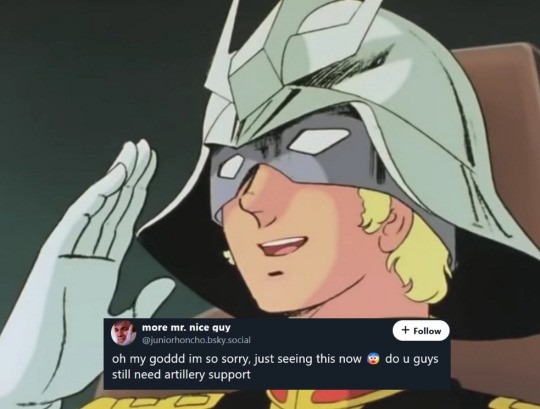
#my roommate and i do refer to garma's fate as 'omg do you still need artillery support'#loadbearing phrase in the vocabulary of us talking abt gundam#imagining char saying this sarcastically btw. he is perfectly aware that garma very much does still need artillery support#charma#char aznable#uc gundam#gundam#gundam 0079
576 notes
·
View notes
Photo

studying
#Suletta Mercury#Miorine Rembran#sulemio#g witch#gundam suisei no majo#mioletta#suletta x miorine#guess that reference?#the witch from mercury#suisei no majo#Kidou Senshi Gundam: Suisei no Majo#Mobile Suit Gundam: The Witch from Mercury#my art#artists on tumblr#wlw
2K notes
·
View notes
Text


case closed!
#my art#detective conan#case closed#masumi sera#I haven't caught up yet but so far she's my fav character#I can't believe it took random gundam references for me to get back into dc after so long lol
118 notes
·
View notes
Text
Translated Keroro Files No.023 - No.045
(more english translated files for the characters in "Keroro Gunso the Super Movie: Gekishin Dragon Warriors de arimasu!")
Numbers 23-55 go over the Garuru Platoon, Shurara Corps, and first movie appearances























Some Additional Notes:
File No.28: I would not agree that keronians don’t like the syringe…
File No. 37: Gundam brainrot is INSANE. he’s basically comparing Gyororo to a type of gundam (used by the Zeon army primarily) that’s used for spying and surveillance. hence reconnaissance
File No. 40: ANOTHER Gundam reference. “Char” here is “Char Aznable,” from the universal century timeline. This file makes zero sense if you’re not gundam rotted
File No.41: I think you can guess what franchise this could possibly referencing. The Zanscare Empire from Mobile Suit Victory Gundam is an antag
File No.42: Start clapping, people, this one is NOT a Gundam reference. He’s yapping about Piccolo from Dragon Ball Z now 😭
— And finally another plug to Soroaxas since I got all of the original files from their bonus video‼️
#i regret saying i liked keroro’s perspective. i’m tired of translating gundam references#keroro gunso#sgt frog#man who should i even tag with this#garuru platoon#shurara corps#keroro gunso the super movie
89 notes
·
View notes
Text
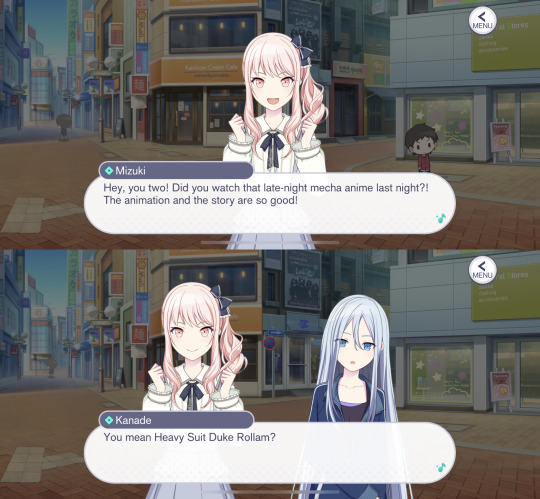
Mizuki likes a mecha anime called Heavy Suit Duke Rollam.
#mizuki akiyama#project sekai#this might be a gundam reference but i don't know enough about mech anime to confirm that#this has been sitting in my drafts for ages
245 notes
·
View notes
Text

Gundam Soundwave, I mean, Gundam Indra. More WfM fan AU ramblings under the cut! (it's 2:35 am, lord help me)
FP/A-67 Gundam Indra is a GUND format prototype MS developed by Peil Technologies and a step between company's Zowort and its later GUND MS, Pharact.
Built for testing the limits of the format and its enhanced pilots alike, it was developed with the Corax GUND Bit system. After Indra's development was discontinued, many of its parts - including the Corax - were implemented into its successor.
During its operation, it was piloted by all five EPs as a testing/training unit, but the permet link was optimized with N°3's brain implants in mind, who's its most frequent test pilot. It is, however, not 100% combat-ready.
#WfM fan AU#washing machine george adventures#gundam#the witch from mercury#I used Zowort Pharact and EVA Mark 06 as inspo/references#kinda looking like Soundwave was not the intention... but you know what why the hell not#we just roll with it#:'D#next time I feel like designing damn mechas... Geroge's MS#I'm Unwell™
54 notes
·
View notes
Text



✿ Kidou Senshi Gundam ZZ ┊ 486 sheets ✿
… a 1986 TV series with character designs by Hiroyuki Kitazume is now available over here.
Scanned by Mark Simmons.
#Kidou Senshi Gundam ZZ#mobile suit gundam zz#gundam#80s anime#retro anime#settei#anime#model sheets#animation#character design#character sheet#reference#inspiration#art reference#art ref#vintage anime#anime 80s
46 notes
·
View notes
Text

What you touch, you don't feel // Do not know what you steal // Destroy everything you touch, today // Please destroy me this way
#gundam#gundam 0079#mobile suit gundam#char aznable#lalah sune#gundam fanart#charma#garma zabi#i keep forgetting to post things on here#oops#my art#song reference#destroy everything you touch
71 notes
·
View notes
Text


Loving how there is always an utena reference hiding in there.
#secondary characters making the secondary characters arc from uteri reference#rgu#g witch#gundam#the witch from mercury#mobile suit gundam#gwitch#gundam the witch from mercury#gundam witch from mercury#gundam spoilers
491 notes
·
View notes
Text

toxic butch yaoi for patron
#char aznable#amuro ray#gundam#arter#charmuro#eteroutsider#damn i sure hope annoying people don't find this post#yes that's a reference for smith college girls for i-D magazine 2004
193 notes
·
View notes
Text

#gundam#hathaway's flash#gigi andalucia#hathaway noa#my art#i opened the reference sheet for xi's cockpit and closed it within 2 seconds im not strong enough to draw that again
25 notes
·
View notes
Text
IBO reference notes on . . . the economic blocs
In episode 4, we are shown this map, depicting the current national organisation of the Earth in Iron-Blooded Orphans' setting.

This raises a number of questions, primarily 'what were they smoking when they decided to combine Canada and Russia'?, secondarily 'what does Gundam have against Australia?', and further, 'what's the deal here?' In the spirit of obsessive nerdery -- and inspired by @qqchurch posting about a particular map prop -- I thought I'd have a crack at pulling together some answers.
Some spoilers and a rhetorical swerve ahead.
The bigger picture
Geographically -- astrographically? -- the solar system of Iron-Blooded Orphans is split into different 'spheres', principally the Earth Sphere and the Outer Sphere. This is a holdover from the original 1979 Gundam series, which used 'Earth Sphere' to refer to the region of space containing Earth, the Moon, and the various orbital colonies located within this gravitational system.
I should note, mostly for myself, that while writing fan-fic for IBO I fell into the habit of writing Outer Spheres, pluralising a term I believe is only ever singular within the canon. This stems from the grouping of both Mars and Jupiter (and presumably the Asteroid Belt) into the Outer Sphere. I would argue that post-canon, the pluralisation makes sense since we then have the Mars Sphere as a discrete political entity, but even without this, grouping two distinct planet/moon groups into one sphere seems to cut against the Universal Century definition given above.
[EDIT: I was mistaken here; Kudelia does in fact use 'Outer Spheres' when discussing Earth and the colonies' reorganisation following the Calamity War. She in fact refers to Mars and Jupiter as Outer Spheres, so either I am misremembering the usage elsewhere, or the terminology drifts later.]
Nevertheless, as a in-universe division it makes sense. Earth is the centre of power in this setting, the other planets existing as its colonial holdings. An 'Inner Sphere' or 'Venus Sphere' (depending on which logic we follow to style it) is also visited in spin-off game Urdr Hunt, having been left to decay now its utility in terraforming Mars is over.
In terms of political organisation beyond the Earth Sphere, we spend most of our time with Mars, which is sub-divided into colonies following present-day naming conventions for Martian topography. The principle action takes place on the Chryse Planitia, with the city of Chryse being this region's capital. The city of Noachis, presumably capital of the neighbouring Noachis Terra, is also mentioned.
In practice, Mars is administered as a whole by Gjallarhorn, on behalf of the Earth political blocs that own the various individual colonies, with the officer in charge of the occupation ruling from the Ares space station. The Venus colonies, including the tethered Radonitisa Colony, are likewise overseen from an Aphrodite station, and we might therefore infer a Zeus station exists too. This is in fact one of the few guesses we can reasonably make about Jupiter, since we never actually visit it during the course of the series. Jupiter's moons are likely inhabited, since four subsidiaries of the Teiwaz conglomerate are named after them (IOS, Ganymede Farm, Euro Electronics, Callisto), and it is also probable there are a number of O'Neil cylinder space colonies in the vicinity (flashbacks with Naze and Amida show them sharing a hotel room aboard such a structure). But we never get any hint of how Jupiter is governed, except that the most powerful organisation there seems to be the aforementioned Teiwaz, a corporate mafia/yakuza (they are at once both Italian and Japanese; it's glorious). No other official body ever comes up.
The division of Mars dates to a few years after the Calamity War, when Gjallarhorn was directed to recreate the Martian government from scratch, following on from overseeing the reorganisation of the Earth into four 'economic blocs', abolishing old national borders. And it is here I shall be focusing this post, to take a look at what we are told about each bloc. For the sake of a structure, I am going to take them in reverse order to how much we know, which means we start with the Oceanian Federation.
The Oceanian Federation
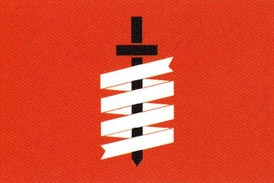
Well, first off, their flag goes the hardest of the four. Just look at this.
That aside, of all the blocs, it is a little peculiar that we know the least about the Federation given theirs is the only non-Arbrau, non-Gjallarhorn territory we spend any time in while on Earth. It is they who offer refuge to Arbrau's ousted Prime Minister Makanai after all, setting him up on a tropical island retreat while he awaits the chance to regain power.


This is an impressively sprawling place, befitting a man of Makanai's station. It displays distinctly Japanese style architecture and decoration, which makes sense given this is the bloc in which Japan is situated (it combines Asia with Oceania). Given Makanai's name and preferred form of dress, it is plausible he is himself from the Federation originally, although there is sufficient cultural overlap on display elsewhere that this is far from a necessary conclusion. Regardless, for their own reasons, they give him sanctuary, up to the point Carta Issue pressures them into rescinding their protection and allowing her to pursue Tekkadan.
In a similar vein, the Federation offers Tekkadan's space-based forces safe harbour at their colonies, as quid pro quo for interfering with the African Union's operations. A different set of (specifically industrial) colonies is later shown in Season 2, undergoing an attempted workers' uprising. Having watched the African Union suffer from the Dort uprising in Season 1, the Federation's leaders are not prepared to risk the same happening to them and they give Gjallarhorn a free hand to violently suppress those involved.


Beyond this, we learn nothing whatsoever of the Federation's people or government. The world map aboard the Montag Company ship that carries Tekkadan from Makanai's island to Arbrau centres Japan, an indication that while Gjallarhorn uses Euro-centric maps, this doesn't represent cultural (or navigational) homogeneity. But this is I think more interesting on a meta level, in regards the positioning of the two maps within friendly and antagonistic factions, respectively. As a world-building detail, it's merely logical for a Pacific-based freighter to carry such a chart.
Going beyond the text and doing a quick spreadsheet calculation based on Wikipedia's summary of 2023 data, the Oceanian Federation would account for a full 50% of the Earth's population, with the African Union encompassing approximately 35%, the SAU 13% and Arbrau a paltry 2%. That, however, does not account for the Calamity War and the consequent extermination of a quarter of the human race. In light of this, we might spin the division as a subtly horrific bit of environmental storytelling. We know mobile armours will prioritise targetting the largest concentration of human beings they can detect. What would this have meant for places like India or China when things ran out of control?
Obviously we don't know the state of population distributions pre-War and the quarter figure is given for the solar system as a whole. Still, if we are to assume the four-way sub-division made some sort of sense in the immediate aftermath of the Calamity War, a proportionally heavy casualty rate for the most populous nations on the planet could provide a possible justification for such an uneven-looking arrangement.
(In case you're wondering, subtracting the entire quarter from the Oceanian Federation shifts the percentages as follows: OF: 34%, AU: 47%, SAU: 17%, A: 2%. I present this as an illustration of alternative distributions rather than a feasible scenario; I don't actually believe there's a way to make the division follow purely from current world population.)
Oh, yes, and per tradition, Australia has a big honking hole in it, a call-back to the original Gundam anime's opening colony-drop, that presumably marks an event from the Calamity War. Like the damage done to the Moon, this is never expanded upon, but it does lend some credence to assuming Oceania bore the brunt of the conflict.
The Strategic Alliance Union (SAU)
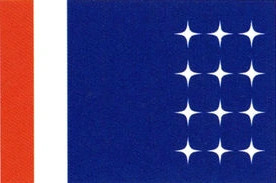
Hello, yes, this is American one.
The SAU's principle role in the plot is to be incited into war against Arbrau as part of Galan Mossa's plan to embarrass McGillis. This scheme takes advantage of a pre-existing border dispute, the exact details of which are not provided: they're far over the heads of our point of view characters. The conflict occurs on 'Balfour Plain', which I take to mean in the vicinity of Balfour, British Columbia. Beyond that, things are left vague.
It does highlight that friction between the blocs is present along lines going beyond mere economic competition. Indeed, it underlines the blocs as competing entities. They operate as nation-states, advancing their own agendas. This extends, following the events of Season 1, to amassing overt military strength.


We can't attribute the mobile suit storehouse show in the opening montage for Season 2 to any particular bloc. But it does house several Hexa frames in addition to Rodis, which ties in with the later appearance of Gildas at the head of the SAU's army. These are Calamity War-vintage 'suits brought out of mothballs after Tekkadan shook things up by deploying at Edmonton, and they make for a notable contrast with Arbrau's own mecha contingent, which consists of brand new Hloekk Grazes bought from Gjallarhorn.
Gjallarhorn also deploys to provide battlefield support to the SAU, indicating the extent to which this peace-keeping force can intervene in inter-bloc conflicts. Perhaps McGillis' forces act on behalf of the putative defender, given the war was instigated when an SAU jet crashes following exposure to an Arbrau Hloekk Graze's unshielded Ahab reactor. Having not considered the situation critical enough to require mobile suits, the SAU views this as unprovoked escalation and appeals for support.
Which brings us to the rest of the SAU's military forces, consisting of planes use for reconnaissance and mobile workers. This tells us jet fights still have a place Post-Disaster, and that the mobile worker industry is eccentrically prolific.


Like Arbrau, the SAU's military is described as inexperienced. I am not sure where to fit an evident air force into that picture: it could be the lack of experience does not denote newness, as it does for Arbrau's defence force, but simply the absence of any active role prior to the declaration of war. Although the bloc's name -- Strategic Alliance Union -- sounds atypically militaristic compared to the others (rather like naming a country after NATO), it is not ascribed greater martial prowess. The conflict boils down to two rag-tag armies chipping ineffectually away at another, falling for Mossa's attempt to bog the region down in a petty, protracted war and thus ruin McGillis' reputation as a peacekeeper.
That about covers the extent of the information we learn about the SAU in the main series. For more, we must turn to Urdr Hunt and...
Well. OK. I am obliging myself to include this, aren't I? The Zahn Clan are introduced in the game as a crime family from the SAU. The two sons of the Clan's founder, Rubian, are dispatched to take part in the titular hunt to test whether they have the chops to succeed him as head of the organisation. I won't go into the plot here; you can look up my summaries or simply go watch it for yourselves. (Note: official translations of the names have since been provided on the website for the upcoming animated adaptation, but some of these seem of slightly dubious quality compared to earlier fan-sourced versions [I don't think 'Lubian' can be right].)
The thing is, the Zahn family -- Rubian, Rome and Aiko -- are African American gangsters. Stereotypically so. Their mobile suits are styled after cars, they're decked out in rings and gold chains, Aiko has a baseball cap, Rome, extravagant piercings, etc. They're a caricature of United States criminality and the problem is, IBO's art-style tends grotesque when it comes to the underworld, meaning the result is, in motion, when the detail level drops, extremely uncomfortable. It certainly doesn't help that the brothers are depicted as buffoons, playing straight the 'comedy relief idiot' trope Iok subverts in the anime proper (that is, Iok is an idiot and it is not remotely funny).
Their dad is *not* a fool, nor is fellow gangster Jabiro, but I really, really wish this didn't hit quite so many racism buttons at once. Nonetheless, they are a depiction of an aspect of the SAU and must be included in a post covering what we know about the blocs.
Rubian has been wildly successful at running his underworld empire. Though old and infirm, he remains extremely sharp, ruling the Zahn Clan from an honest-to-goodness castle in his home territory. I have no idea which way this cuts with regard to racist caricatures. It seems to be suggesting a level of in-universe tastelessness but quite frankly, I don't think I can fault a mobster who gets wealthy enough to go, 'I'll live like a literal king'.


In terms of the Zahns' relationship to their home bloc, I noted in another post that they are remarkably well-equipped, fielding top-of-the line 'suits alongside more venerable models (including a lot of Gildas) and surplus Gjallarhorn spacecraft. While we know 'top-down' corruption is rife in the Earth Sphere in the sense of Gjallarhorn members empowering themselves by overstepping the bounds of neutrality, the Zahns demonstrate that 'bottom-up' corruption is alive and well too. Indeed, they are described as being explicitly 'backed' by the SAU , with a presence in all of the SAU's territory on Earth and having both Gjallarhorn and government officials in their pocket.
As is to be expected, the blocs are as sordid as contemporary nations, with the criminal classes very much in on the act.
The African Union
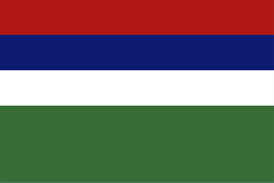
That's the Republic of Gambia's flag rearranged into something less cool.
I hesitate to classify the African Union conspiring with Gjallarhorn against the workers unions as an act of corruption, on the principle that 'corruption' implies the system is not functioning as intended. Far from being broken by moving to curtail the activism of people who are (theoretically) its citizens, the Union works to perpetuate its interests, something judged to have been harmed when it eventually concedes to some of the workers' demands. These are economic blocs, after all. Extracting profit and generating wealth is the tacit reason for their existence.
Let's back up. I've re-litigated Season 1's Dort Colony arc in multiple essays at this point, largely because it is a capsule of the series' themes. The struggles of the people who operate industrial facilities for the benefit of "rich factory owners from Earth" -- who live in splendour compared to the slums where the masses are relegated -- culminates with a bloody massacre, Gjallarhorn having manufactured an excuse for violence by allowing tensions to escalate to the point of armed insurrection. These events provide a snapshot of how the writers conceive of colonial and anti-labour oppression, a demonstration of the injustices that permeate every level of the society they have imagined, and an ambiguous moment of success for the protagonists. Kudelia Aina Bernstein gets to be the brave, fearless 'maiden of revolution', photogenically turning the media apparatus against government overreach. But it is underpinned by dubious backroom deals and a sense of how easily things could have gone the other way. This won't be the last time Tekkadan faces the Arianrhod Fleet and their visible insignificance before hundreds of ships and mobile suits is sinisterly prefigurative in retrospect.
For my purposes today, there are two important components to this arc. Well, three really, but we can take Gjallarhorn's utility as the blocs' enforcer as read. So -- the first is how the African Union relates to those living aboard the space colonies, and the second is the way in which those colonies are run for its benefit.
The Dort Company is described as running the colonies as a 'public enterprise' for the Union. As I mentioned in an aside while writing about how IBO engages with capitalism, this creates a surface-level contradiction where we have factories privately owned, presumably for profit, but the colonies themselves framed as a public service. Yet I don't think anybody familiar with how privatisation consumes such services will have a hard time reconciling this. The degree to which the Union is or is not doing state capitalism is ultimately irrelevant: the conflict is between the workers and the company that employs them, as a proxy for the bloc that consigned them to a miserable existence as expendable labour.


The Dort Company is an extremely prominent presence, their branding displayed at scale and their workers all sporting green jackets. 'Dort', by the way, is the historical English name for Dordrecht, the oldest city in Holland and a shipbuilding centre for the Netherlands Trading Society, which maintained shipping lines to the 'Dutch East Indies' (Indonesia). Dordrecht also gave its name to a town in South Africa, in a further link to European imperialism. I can't be sure to what extent IBO's writers were deliberately evoking that history, but it seems unlikely to be an idle connection. The Dort Company is a tool of an Earth-centric empire, maintaining the industrial mechanisms that sustain the African Union, space colonies having taken the place of 'third-world' manufacturing centres. This is where consumer goods are produced, for those who live well, by those who scrape by in poverty.
The visuals sell this with straightforward bluntness. We are shown the slums that house the workers and we are shown the shopping centres frequented by the factory-owning class. Yamagi comments, on seeing the home of labour union leader Navona Mingo on Dort 2, that he expected the colonies to be a lot nicer. He was perhaps picturing the kind of environment Mikazuki, Biscuit, Kudelia, Atra and Fumintan explore aboard Dort 3, a 'first-world' cityscape. The point being made is that these contrasts go together, often in the very cities that look so good on the surface. There is always a disposable underclass, always exploitation required to fuel superficial prosperity.


What I find interesting is that in none of this do we ever see the 'true' African Union, the society the Dort Colonies exist to serve. We never meet any representatives of the Union itself: Gjallarhorn deals with Dort Company executives and faceless communiques. Even in spin-off manga Moon Steel, where the bribery of Gjallarhorn officers by African Union officials is a key plot point, the action remains focused on the space colonies, on the people living in what is essentially captive territory.
This is likewise true for the previous two blocs I've covered and it's a canny choice, centring the struggles of the colonial subjects. The African Union has a 'ruling council'. But our sole insight into them is that they decide to reverse course and put a stop to Gjallarhorn's anti-labour operation at the last minute, afraid of the media exposure Nobliss Gordon arranged for Kudelia. The Dort Company then comes to the table with the (remaining) workers, granting labour rights equal to those existing on Earth.
Obviously this tells us such rights are not the general rule in the colonies, that employees on Earth enjoy privileges denied to those in space, and that the Union leadership is sufficiently sensitive to bad press, they don't want to be seen to sanction the killing of hundreds of colonists. At the same time, what is not said is also significant. We don't know, precisely, what 'rights equal to workers on Earth' materially entails. McGillis' backstory establishes the existence of a terrestrial underclass. There is every reason to believe Yamagi's misapprehensions hold true for the planet as they do for the space colonies: there is no land of wholesale luxury, just the same hierarchical, exploitative structures repeated in different locations.
I admit to finding the idea of Europe being subsumed into an African Union a deliciously ironic one. As a background detail, it's shallowly pleasing. Implied turnabout. But that doesn't matter, does it? Any redress of historical crimes is overshadowed by the fact nothing has been fixed. The same old imperial structures are reiterated, the same old injustices perpetuated. Who is being exploited is of lesser concern than that exploitation is occurring. That's why the details of the blocs' governmental structure and home conditions are largely irrelevant. They are powerful national entities engaged in the operation of capitalism at the expense of their subjects. Whether those operations occur in Indonesia, high orbit or on Mars, the flaw lies in the basic structure of the relationship.
Someone is being worked to death so that someone else, distant or otherwise isolated from this material reality, can profit.
Arbrau

OK, now you're just throwing shapes at a background.
It is inevitable that the bloc we are told the most about should be the one that owns the territory in which the story begins. Chryse is an Arbrau colony; ergo, it is with the Arbrau government that Kudelia must negotiate in order to improve the lot of her fellow Martians. Season 1 is about reaching the heart of this bloc's power, the parliament in Edmonton, Alberta, an aim that morphs into restoring Togonosuke Makanai to the office of prime minister and stymieing the machinations of his Gjallarhorn-backed rival, Henri Fleurs. At last, we can take a look at how Iron-Blooded Orphans conceptualises the political functions of its quartered Earth.
Gundam Wiki states that Arbrau "appears to be a parliamentary democracy" and, while I occasionally have cause to take issue with the editors at that site, this is entirely correct. There is a parliament, as mentioned, a prime minister, a debating chamber, and elections. It is an overtly civilian institution, in contrast to Gjallarhorn's militaristic aristocracy. It is overtly civilised, in the sense of being a bunch of people in business suits ruling a nation.


I should clarify immediately, not least because this threw me on first viewing, that it is not the form of parliamentary democracy found in modern-day Canada. The way the election of the prime minister works is modelling (unsurprisingly) on the Japanese system, where the legislative body holds responsibility for nominating someone to that position (rather than it being de-facto filled by the leader of the dominant party). Hence Makanai and Fleurs courting the support of various ministers and the election being entirely contained within the bounds of the sitting government.
In the epilogue to the series, Lasker Alessi talks about having a constituency, hoping Takaki will take over from him there in the future. We can take from this that Arbrau is a representative parliamentary democracy (not a given; parliaments can operate without representing the citizenry), and therefore that it is more or less the assumed default in the context where the show was written. This is what politics is 'supposed' to look like.
These markers of familiarity are worth bearing in mind when considering the ways Arbrau is depicted as being overtly sympathetic. Makanai has long championed greater economic freedom for the Chryse region; indeed, Arbrau was the first of the blocs to grant limited autonomy to its Martian colonies, some hundred odd years prior to the present. The parliament members respond favourably to Kudelia's landmark speech before them. Later, Alessi takes Takaki on as his protegee, and Edmonton is where the Human Debris Abolishment Treaty is signed.


Furthermore, Chyrse is the only colonial holding Arbrau is shown to possess. While Governor Norman Bernstein is a craven, cowardly man who sells out his own daughter, he is also depicted as being in Gjallarhorn's pocket, part of the (textual, actual) corruption miring the governance of Mars. It is Gjallarhorn who work to uphold the present colonial arrangements, opposing those more open to change. They are behind Fleurs and her temporary ousting of Makanai. Lord Iznario Fareed might be acting for his own personal gain, but he also represents the factions who wish for things to continue as they are, in opposition to McGillis's revolutionary movement and Rustal Elion's (eventual) reforms.
If Arbrau has its own equivalent of the Dort Company, this is kept off-screen. Is it reasonable to assume it does? We know from Urdr Hunt that Dort is one colony management company among many -- the Omden Colony Company is arguably even worse -- so it's far from implausible that Arbrau would have a similar arrangement with its own set of industrial colonies. There is also mention of an 'Outer Sphere Development Corporation' on Mars, which sounds very much like what you would name something that went around exploiting poorer nations for the betterment of shareholders in richer ones. And besides, Chryse has definitely not done well out of Arbrau's nominal stewardship. Abandoning the colony to Gjallarhorn's rule speaks to how little regard has been shown to the people living there, not to mention that while Makanai says his belief in advancing their cause is long-held, it has amounted to very little concrete difference over the course of his presumably lengthy career. Kudelia's trip to Earth is a clearly necessary spur to action.
Action results, though. The restrictions on Chryse are eased, a step toward Mars becoming an independent state. Arbrau is the vanguard of a change in attitude towards the red planet. Perhaps then we should ask why this bloc among the four would be the one to begin this process (beyond the mere narrative convenience of 'that's where the majority of the cast come from').
As I alluded to at the top of this post, I struggle to see the sense in joining Canada, Alaska, Russia and Svalbard together when you're also combining India and China, the entirety of Europe with the entirety of Africa, and the majority of the Americas into one. It really doesn't follow from modern population distributions, nor can I imagine it being an easy stretch of geography to manage. That it should be ruled from Edmonton is additionally baffling; it's not like Russia doesn't have existing civic infrastructure, placed at an awkward distance from this capital.
We can of course attempt to fill in the blanks. We might say a large number of refugees were displaced north during the Calamity War, fleeing densely populated areas for the relative safety of Russian and Canadian wildernesses. There is something compelling about this idea, that Gjallarhorn had to redraw the map simply based on where people ended up once the dust settled.
But let's take Arbrau as given: an expanse of tundra, connected by trains the prime minister doesn't seem to have known were there. Even admitting there are a great many large cities continued within its borders and assuming an increased population, it looks paltry in comparison to the other blocs, seeming to lack large amounts of colonial territory and needing to create a defence force from the ground up when tensions escalate. Where the SAU and the African Union display pre-existing mobile suit stockpiles (placed in the hands of the SAU military and the Dort Company, respectively), Arbrau must buy new 'suits from Gjallarhorn and rely on mercenary groups like Tekkadan to train its recruits.
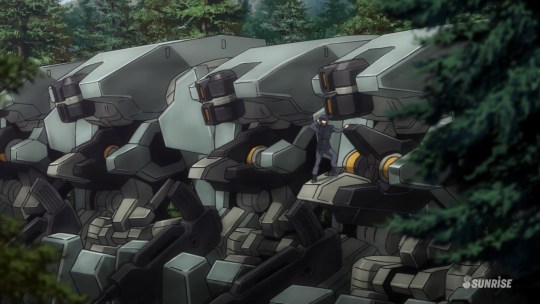

Overall, everything we learn of Arbrau makes it appear weaker than its counterparts and maybe that in itself is why it should be at the forefront of letting go of Mars. Empires are only worthwhile so long as the costs are outweighed by the gains. A weaker bloc is less likely to make that equation work. Ergo, once Chryse is more trouble than it's worth -- say, because the governor's daughter just parked a paramilitary group run by teenagers on the front lawn -- letting it go becomes an inevitability.
As much as Makanai is broadly on the side of our protagonists, he remains an ambiguous character. He is openly self-serving, threatening Tekkadan into assisting him and frequently espousing a hard-hearted, cynical world-view. If he wasn't just flattering Kudelia, then he genuinely gave little thought to the infrastructure that operated at the ground-level of his nation. He later goes on to treat a greater sense of the moral weight of his actions (following a brush with death) as a personal failing. Given all this, it is unfeasible he would act without considering the economic realities of possessing colonies, good and bad. Thus, his decision to support Kudelia must also benefit Arbrau, freeing them of an economic burden and -- perhaps -- sowing discord among Arbrau's rivals.
This is, once again, speculation, filling space in the narrative where details are not required. To return to my earlier point, the nature of the blocs is far less important than their presence as oppressive forces. They and their representatives signify wealth and power imposing itself upon a wider world. Indeed, signifiers of wealth take the place of any technicalities of the colonial system. The Governor's residence in Chryse is of a piece with Dort 3 and even with Rubian Zahn's castle. This is what the ruling class looks like, in Iron-Blooded Orphans, and the visual obviates the need for explanation.
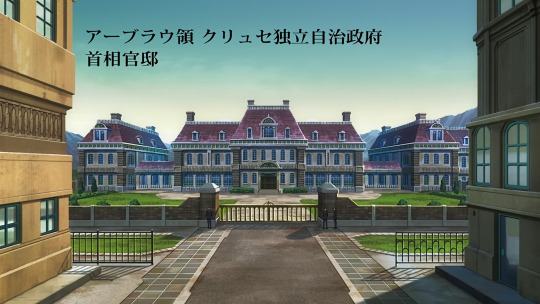
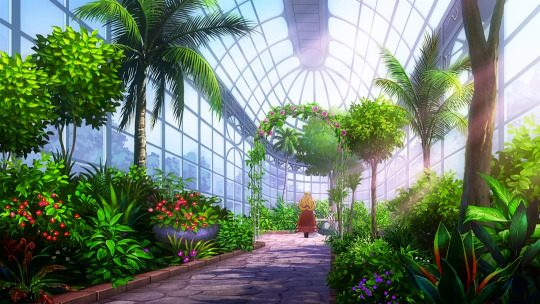
The Arbrau parliament is the same kind of shorthand. The image of a reasonable political system that, though it may suffer from bad actors, can still be gamed to create good results. It's only natural for it to resemble the form of government socially agreed upon to be correct, by dint of it being the one outside.
Yet, as with everything else IBO does, there is a pleasing degree of problematisation on display. Makanai is the only significant human face provided for the blocs and he is, beneath his oft-times jovial affect, a cold, aloof pragmatist who acts to secure his own position first and foremost, personal beliefs subject to the flow of power around him. His status as a helpful, progressive figure is tinged by his being at home within the broader context. Reasonable and proper though parliamentary democracy is in principle, the reality is still assumed to be unpleasant.
Indeed, can a 'democracy' that owns/owned colonies be anything else?
Cartographical gestures
Let's get this out of the way: the economic blocs as depicted are exactly as fleshed-out as the block-colour map shown in episode 4. That is to say, they are shorthand for global superpowers engaged in a vast, sprawling competition. There is little culture, political nuance, or comprehensible structure instilled into them. These are simply not things Iron-Blooded Orphans cares about exploring and there's no connective tissue to be 'decoded' from what we're shown.
As ever, we can speculate wildly (and have a lot of fun doing so), and unpick what the sketched background tell us about the creators' assumptions and approach. We can question how they envision government bodies, military build-up, American criminality, even what 'rich' looks like. But it is important to be able to step back and really grasp what we are looking at.
The episode 4 map is there to inform the audience that the world is divided between massive superpowers, that the division was enacted by Gjallarhorn, and that the results define where and why our heroes are going on their journey. The actual details of the division are irrelevant. Further, the differences between the blocs are far less significant than their similarities. At the start of the show, they all possess colonies, they can all be assumed to be party to oppressive acts, we have no reason to think their systems of government differ much (they were all set up by the same group of people, at the same time), and their reactions to developments in the setting are of a piece. They even release their hold on Mars in unison! Arbrau gets cast in a more positive light than the others, but that has more to do with Makanai's role as a (relatively) reasonable authority figure. It's not hard to imagine the introduction of equally reasonable characters representing the other blocs, with no change to the underlying message that the blocs at large are callous, indifferent, and imperialistic.
Suffice to say, I think this is the right decision for the story Iron-Blooded Orphans is telling. It is also an entirely unremarkable move, hand-waving a larger world as justification for a particular plot. But I find myself considering the a conceptual floor represented by that map. A geopolitical why underlying Makanai's behaviour is not extant because the story is about the difficulty of reaching those in power with pleas for improvement. Within this framework, he just is a supporter of Martian autonomy and that's that. Digging beneath this is writing fan-fic, not extracting 'lore' or canonical detail.
Ultimately, I take from that a lesson in a piece of fiction's priorities. We have here a marker of a certain geopolitical relationship, within a tale about oppression primarily told from the perspective of the oppressed, that is not strictly concerned with the mechanics of said relationship but rather what it entails.
The map is wallpaper.
Interesting, simplistic, potentially insensitive wallpaper that can be used as the basis for some good stories.
Yet wallpaper all the same.
[Index of other writing]
#gundam iron blooded orphans#gundam ibo#g tekketsu#tekketsu no orphans#reference#notes#arbrau#SAU#oceanian federation#african union#dort company#Togonosuke Makanai#fictional politics#flags
43 notes
·
View notes
Text
Ez8 🤝 Optimus Prime




Megs and Gouf are unimpressed

#gundam#gunpla#gundam rx-79[G]Ez8#ez8#Optimus prime#transformers#gouf#this aint no zaku#oh waits thats a different gouf sorry ramba#Megatron#Skybound reference#well technically ms08 reference#i mean it's both#but yaknow
23 notes
·
View notes